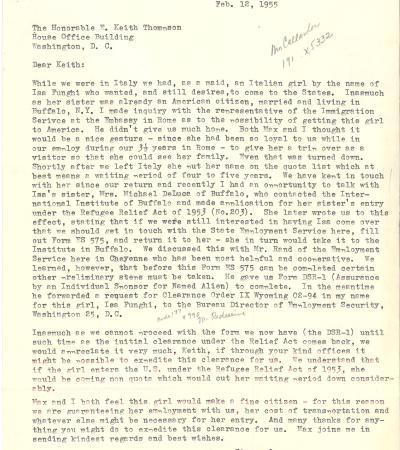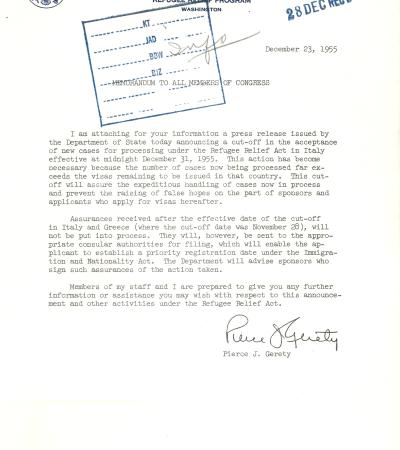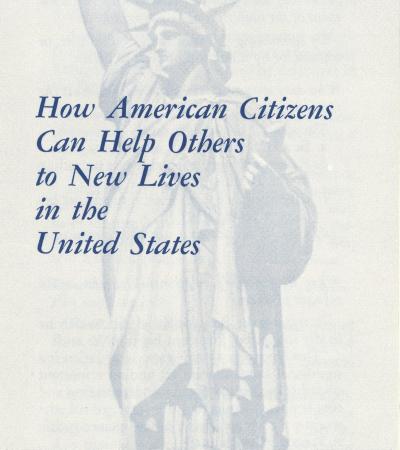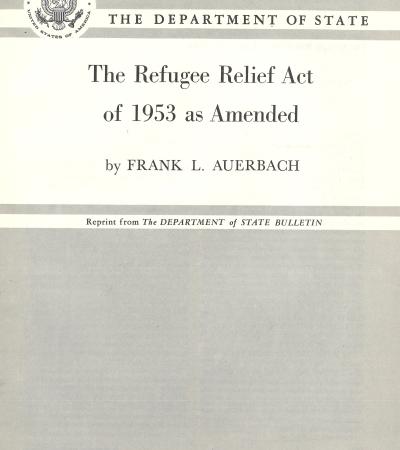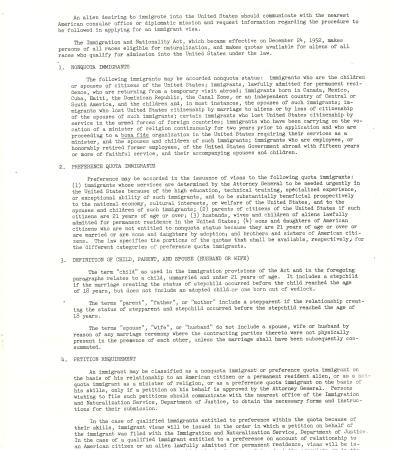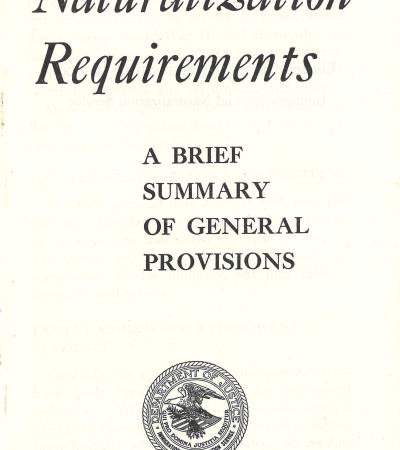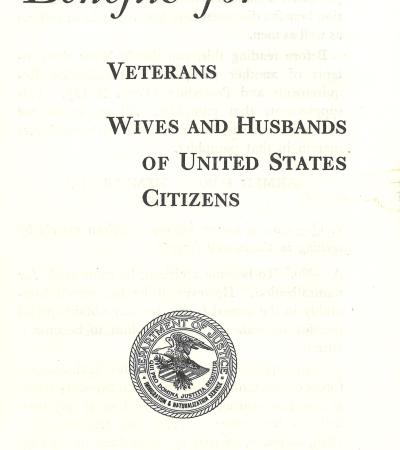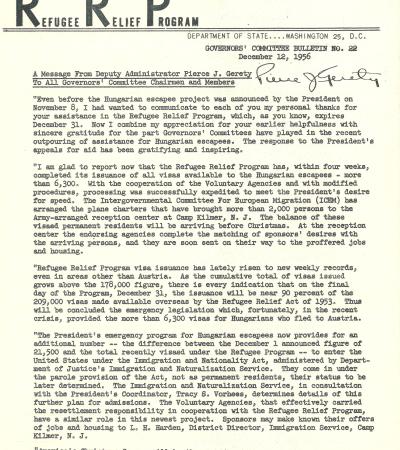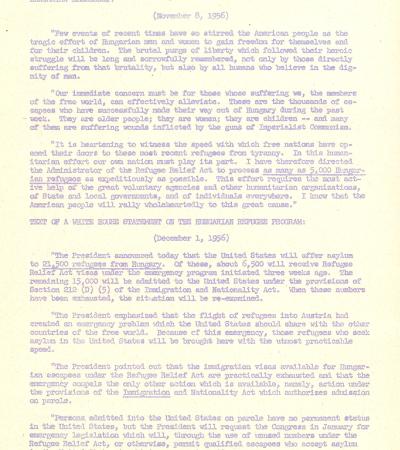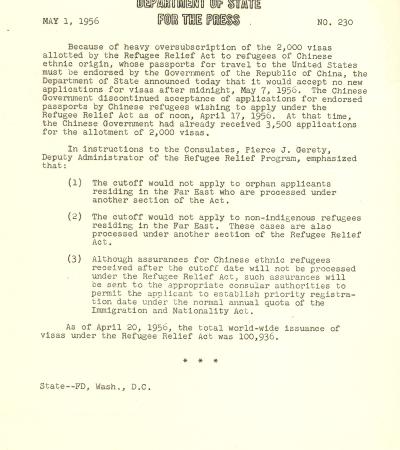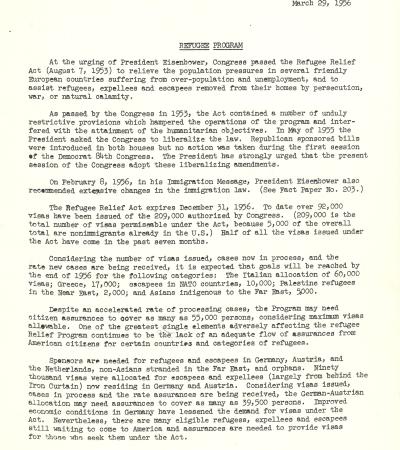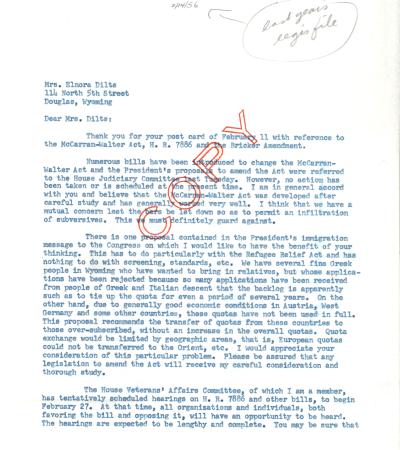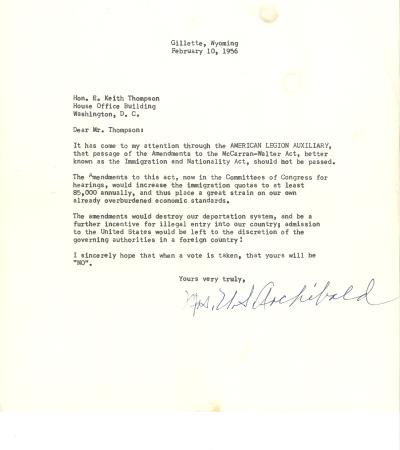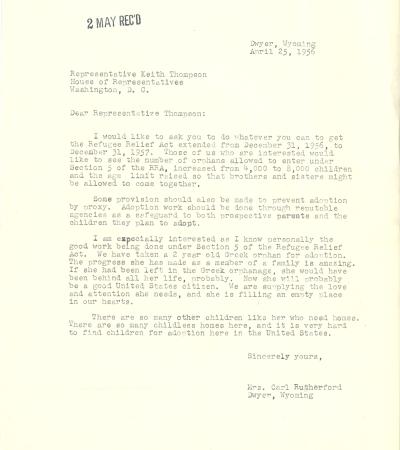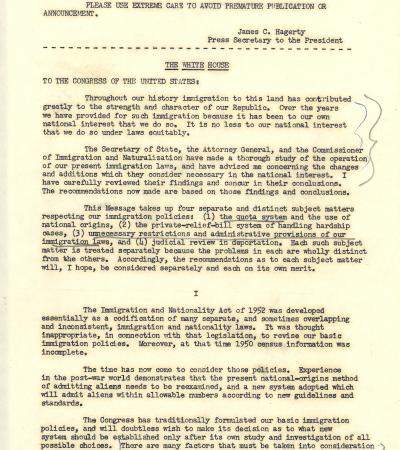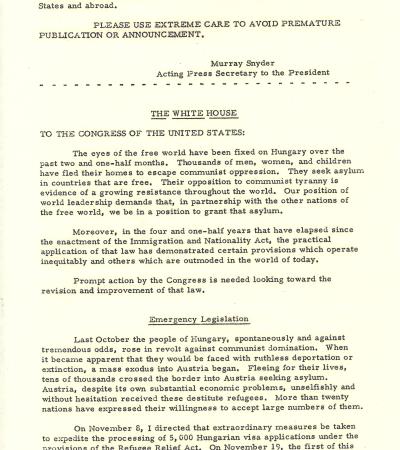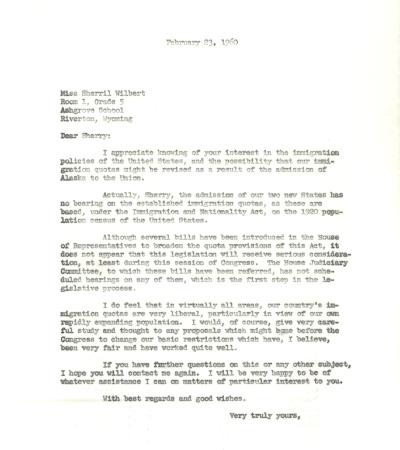Edwin Keith Thomson (1919-1960) was a Wyoming politician. A Republican, he began his career in politics in 1952 when he was elected to serve in the Wyoming State House of Representatives. In 1954 he was elected to represent Wyoming in the U.S. House of Representatives where he served three terms. In 1960 he was elected to represent Wyoming in the U.S. Senate, but he died before his term in office began. His papers include files related to the U.S. Immigration and Naturalization Service and the U.S. House of Representatives Judiciary Committee on Immigration as well as constituent correspondence related to immigration issues.
Letter from W. Robertson to Congressman E. Keith Thomson, February 12, 1955
This letter, typical of the many received by Thomson, asks for Thomson's assistance in an immigration matter. It gives some insight into the complexities faced by those seeking to immigrate to the U.S.
Department of State Memorandum, December 23, 1955
This memorandum and the attached press release announces a cut-off in acceptance of new applications for visas for those seeking to emigrate from Italy to the U.S. under the Refugee Relief Act.
U.S. Refugee Relief Program Brochure, 1954
This brochure contains questions and answers for American citizens seeking to help refugees establish new lives in the U.S. under the Refugee Relief Program.
U.S. Department of State Bulletin by Frank L. Auerbach, September 27, 1954
This bulletin covers details of amendments made in 1954 to the original Refugee Relief Act, which aimed to provide humanitarian aid by granting visas to refugees fleeing Communist persecution, war, and natural disasters. The amendments expanded visa eligibility, removed certain bureaucratic barriers, and emphasized security provisions to regulate the admission of refugees, escapees, and displaced persons into the U.S.
U.S. Department of State Memo, November 30, 1954
This memo explains the process for granting first preference quota status under the Immigration and Nationality Act to skilled immigrants whose expertise is urgently needed in the U.S. It details the petition process, the role of the Immigration and Naturalization Service, and provisions for accompanying spouses and children.
U.S. Department of State Memo, April 4, 1957
The memo outlines general information regarding immigrant visas, detailing the eligibility criteria under the Immigration and Nationality Act of 1952. It explains different categories of immigrants, including nonquota, preference quota, and nonpreference quota immigrants, the required documents, quota determination, and the burden of proof for visa applicants.
U.S. Naturalization Requirements, 1956
This brochure summarizes the requirements for immigrants to naturalize as a U.S. citizen. It covers procedures for naturalization, including eligibility criteria, residency obligations, and necessary documentation. It also explains the process of filing petitions, attending hearings, and obtaining citizenship certificates.
Special Naturalization Benefits for Veterans Wives and Husbands of U.S. Citizens, 1956
This brochure summarizes the special benefits accorded to immigrant veterans and immigrant spouses of U.S. citizens that seek to naturalize as U.S. citizens. It covers exemptions from standard residency and physical presence requirements and outlines eligibility conditions, required documentation, and application procedures for these groups, making the naturalization process easier for them.
Department of State Message, December 12, 1956
This message was sent to all the Governors' Committee chairmen and members regarding the Refugee Relief Program. It reports that all visas available under the program for Hungarian refugees—over 6,300—have been issued within four weeks, with expedited processing and coordination from voluntary agencies. The memo highlights the growing total of issued visas and an emergency expansion of the program to admit an additional 21,500 Hungarian refugees under the Immigration and Nationality Act.
President Eisenhower's Statements on U.S. Assistance in the Hungarian Emergency, 1956
Eisenhower’s statements expresses deep sympathy for Hungarian refugees fleeing Soviet oppression and outlines the United States' commitment to providing asylum to them. He announces an emergency program to admit thousands of refugees through expedited processing under the Refugee Relief Act and the Immigration and Nationality Act, emphasizing America’s humanitarian duty and international cooperation in responding to the crisis.
Department of State Press Release, May 1, 1956
The press release from the U.S. Department of State announces the closure of new visa applications under the Refugee Relief Act for Chinese ethnic refugees after May 7, 1956, due to oversubscription, as the Chinese government had already received 3,500 applications for the 2,000 allotted visas.
Refugee Program Memo, March 29, 1956
The memo discusses the progress of the Refugee Relief Act, which was enacted to assist refugees from overpopulated and war-affected countries, highlighting the need for additional sponsorships from American citizens to meet visa allocations. It emphasizes the challenges posed, including a lack of assurances from U.S. sponsors, and calls for increased support to help refugees secure jobs and housing, with the assistance of charitable organizations and state-level committees.
Letter from Representative Keith Thomson to Elnora Dilts, February 14, 1956
Thomson writes to Dilts regarding the McCarran-Walter Act and proposed amendments to the legislation. He particularly mentions difficulties prospective Greek immigrants have, given a large backlog in immigrant visa applications from Greece and low quotas for Greece.
Letter from Mrs. U.S. Archibald to Representative Keith Thomson, February 10, 1956
Archibald writes to Thomson expressing her concern about amendments to the McCarran-Walter Act. The letter is typical of the correspondence received by Thomson from his constituents.
Letter from Mrs. Carl Rutherford to Representative Keith Thomson, April 25, 1956
Rutherford writes to Thomson regarding the Refugee Relief Act. She tells of her experience adopting a Greek orphan and urges Thomson to support doubling the number of orphans allowed to immigrate to the U.S.
Presidential Press Release, February 8, 1956
This press release, addressed to the U.S. Congress from President Dwight D. Eisenhower, calls for updating U.S. immigration laws to make them fairer and more flexible. He proposes changes like increasing quotas and easing rules for skilled workers and families.
Presidential Press Release, January 31, 1957
This press release, addressed to the U.S. Congress from President Dwight D. Eisenhower, asks Congress to improve immigration laws, specifically by helping refugees fleeing communism, like those from Hungary, and by making the system fairer and more modern.
Letter from Representative Keith Thomson to Sherril Wilbert, February 23, 1960
Thomson writes to Wilbert regarding immigration quotas, noting that they have been set based on the 1920 population census. The letter gives insight into Thomson's perspective on the immigration quotas set under the Immigration and Nationality Act.
